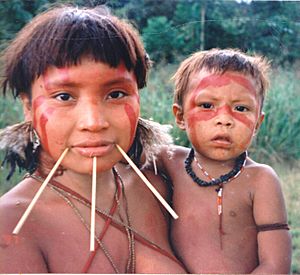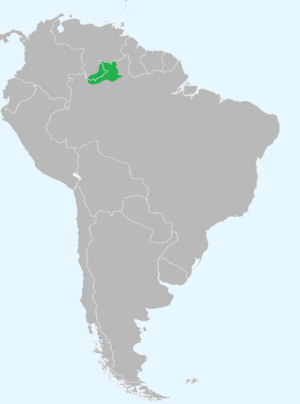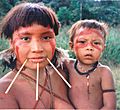Yanomami facts for kids

Yanomami woman and her child, June 1997
|
|
| Total population | |
|---|---|
| approximately 35,339 | |
| Regions with significant populations | |
| 16,069 (2009) | |
| 19,420 (2011) | |
| Languages | |
| Yanomaman languages | |
| Religion | |
| Shamanism | |
The Yanomami are a group of about 35,000 indigenous people who live in the Amazon rainforest. Their villages are found along the border between Venezuela and Brazil. They are known for their unique culture and way of life.
Contents
- What does the name Yanomami mean?
- A Brief History of the Yanomami
- How Yanomami Communities are Organized
- Daily Life in a Yanomami Village
- Why do the Yanomami adorn their bodies with sticks?
- Challenges Faced by the Yanomami
- Yanomami Language
- Groups Helping the Yanomami
- Yanomami in Popular Culture
- Images for kids
- See also
What does the name Yanomami mean?
The name Yanomami comes from their own language. It means "human beings." This helps them tell themselves apart from animals or strangers. Sometimes, they use slightly different names for groups living in different areas. For example, Yanomawi is used for those north of the Orinoco River.
A Brief History of the Yanomami
The first time people from outside the Amazon heard about the Yanomami was in 1654. An explorer named Apolinar Diez de la Fuente mentioned them. For a long time, the Yanomami lived mostly isolated. Other groups in their area were affected by slave hunters between 1630 and 1720. We don't know how much this affected the Yanomami.
More regular contact with the outside world began in the 1950s. Missionaries arrived, wanting to share their beliefs. In the 1970s, the Brazilian government started building roads and setting up projects in the Amazon. This brought more people into Yanomami lands.
Later, in 1975, valuable minerals were found. This led to a big gold rush starting in 1987. Thousands of gold miners, called garimpeiros, entered the Yanomami territory. They built secret runways and caused many problems.
To protect the Yanomami, a group called the Pro-Yanomami Commission (CCPY) was formed in 1978. They worked hard to get the Brazilian government to create a protected area for the Yanomami. After 13 years, in 1992, a large area of land was officially set aside for them. This land, about 96,650 square kilometers (37,320 square miles), is now protected by law.
In Venezuela, a similar protected area was created in 1993. It aims to keep the traditional way of life safe for the Yanomami and other local groups. However, even with these protections, there are still challenges.
How Yanomami Communities are Organized
The Yanomami don't see themselves as one big group. Instead, they live in many separate villages. Each village makes its own decisions. Villages often work together because their families are connected.
Older men usually have the most power in the village. A tuxawa, or headman, leads each village. But there isn't one leader for all Yanomami. Headmen become leaders by being good at solving problems within their village and with other communities. Important decisions are usually made when most of the older men agree.
Daily Life in a Yanomami Village

Yanomami families live together in villages. A village can have anywhere from 50 to 400 people. Everyone in the village lives under one big roof called a shabono. A shabono is usually oval-shaped with an open space in the middle. It's built from natural materials like leaves, vines, and tree trunks from the rainforest.
Because of rain, wind, and insects, new shabonos are built every 4 to 6 years. Inside the shabono, there are no walls. Support posts mark off different areas for each family.
The Yanomami get their food from the rainforest. They use a method called slash-and-burn horticulture to grow crops like bananas. They also gather fruits and hunt animals and fish. Crops make up about 75% of their diet. When the soil in one area gets tired, they move their gardens to a new spot. This helps the forest recover.
Women are mostly in charge of raising children. Young children stay close to their mothers. Girls learn to help with chores from a young age. Boys usually start learning from the men around age 8.
Yanomami women are very busy. They work in the gardens, gathering fruits, roots, and nuts. They also look for insects like termites and grubs, which they roast for food. Some women fish for several hours a day. They also prepare cassava, a root vegetable, by removing its toxic juice and making flat cakes called casabe.
The Yanomami diet is naturally low in salt. Because of this, their blood pressure is often very low. Scientists have studied them to learn more about how salt affects blood pressure.
Rituals are a big part of Yanomami culture. They celebrate good harvests with large feasts, inviting nearby villages. This helps them keep good relationships with their neighbors. During feasts, they eat a lot and decorate themselves with feathers and flowers. Women dance and sing late into the night.
Yanomami women also weave and decorate baskets using bark and roots. They use a red berry called onoto or urucu to dye their baskets and to paint their bodies.
Why do the Yanomami adorn their bodies with sticks?
The Yanomami decorate their bodies with sticks for several reasons. One reason is to show off their cultural heritage. They also do this to celebrate personal achievements and important life events. These events include becoming an adult or becoming a parent.
Challenges Faced by the Yanomami
The Yanomami have faced many serious problems, especially because of gold mining. From 1987 to 1990, many Yanomami suffered from diseases like malaria and mercury poisoning. They also faced malnutrition and violence due to the large number of gold miners in their territory.
The Yanomami also face environmental threats. These include deforestation caused by logging, building roads, and gold mining. These activities harm the rainforest they depend on.
Yanomami Language
The Yanomaman languages family has four main types: Ninam, Sanumá, Waiká, and Yanomamö. There are also many local differences and dialects. This means people from different villages might not always understand each other. Many experts believe the Yanomaman languages are unique and not related to other languages in South America.
Words in Yanomami Languages
Here are some basic words from different Yanomami language types:
| gloss | Shirianá | Parimiteri | Sanemá | Pubmatari | Waica | Karime | Paucosa | Surára |
|---|---|---|---|---|---|---|---|---|
| one | kauitxamhét | chaamí | muliman | mahón | ||||
| two | tasíma | polakabí | botokaki | porakabö | ||||
| three | tasimaimhét | hiːriːpólagʔa | prukatabö | |||||
| head | bel-éhe | pil-héawan | pi-hé | pei-hé | pei-yáhe | ne-umgipe | peːiua-hé | |
| ear | beli-yaméke | pilmórokwiːn | pi-xinkawán | yímikek | pei-yameke | peːiua-niumekakeː | ||
| tooth | beli-uáke | pil-nákwan | pi-nakuán | pei-uák | pei-uáke | ne-parike | peːiua-uáke | |
| man | horóme | waro | wandzyé | wanodá | ũálõ | uáru | uau | uhanó |
| water | mãepe | madzyu | maduú | mãõ | mahu | maú | maú | |
| fire | oáke | kwárogʔe | kuadák | koawáke | oáke | uauká | kauːwaká | |
| stone | mamáke | muadamiːn | máma | mama | ||||
| sun | belipshí | pilmórokwiːn | pilmoró | motóka | motúka | mitukaki | peniboːínshi | |
| manioc | nazygóke | naasʔís | nashita | makóke | ||||
| jaguar | déhe | póleawan | poʔlé | íla | téhe | ührá |
Conflicts and Challenges
The Yanomami have sometimes faced violent conflicts. In 1993, near Haximu, Brazil, a group of gold miners attacked some Yanomami. This led to a fight where people from both sides were killed or hurt.
In 2012, there were reports of another attack in Venezuela. However, later investigations by journalists could not find enough evidence to confirm the claims.
Groups Helping the Yanomami
Many groups work to support the Yanomami people.
- David Good, whose mother is Yanomami, started The Good Project to help them.
- Survival International, a group from the UK, works to raise awareness about the human rights of the Yanomami worldwide.
- In 1988, the World Wide Fund for Nature (WWF) helped fund a musical called Yanomamo. It tells the story of the Yanomami and their rainforest home.
- Yanomami-Hilfe e.V., a German group, builds medical stations and schools for the Yanomami in Venezuela and Brazil. Its founder, Rüdiger Nehberg, even crossed the Atlantic Ocean to draw attention to their struggles.
- The Yanomami in Brazil have their own organization called Hutukara Associação Yanomami.
Comissão Pró-Yanomami (CCPY)
CCPY is a Brazilian group that helps improve health care and education for the Yanomami. It was started in 1978 by a photographer, an anthropologist, and a missionary. CCPY worked hard to protect Yanomami land rights and their culture.
After the Yanomami Indigenous Area was created in 1992, CCPY helped reduce malaria among the Yanomami. They taught Yanomami people how to diagnose and treat the disease. This led to a 45% drop in malaria cases between 1998 and 2001.
CCPY has also helped the Yanomami by supporting projects for growing fruit trees. They also set up schools in villages. These schools teach Portuguese, which helps the Yanomami deal with Brazilian politics and other groups. They also learn about money and how to keep records.
Yanomami in Popular Culture
- The musical Yanomamo by Peter Rose and Anne Conlon (1983) shares their story.
- The 2008 Christian movie Yai Wanonabälewä: The Enemy God featured a Yanomami person telling their history.
- In the Italian comic book Mister No, the main character often interacts with the Yanomami.
- Chilean artist Juan Downey made a documentary in 1979 called The Laughing Alligator about his time with the Yanomami.
- The 2017 Bengali film, Amazon Obhijaan, shows the Yanomami helping the main characters find the mythical city of El Dorado.
- Illusionist David Blaine featured the Yanomami in his 1997 TV show Magic Man.
Images for kids
See also
 In Spanish: Pueblo yanomami para niños
In Spanish: Pueblo yanomami para niños





